Welcome to our guide on successfully mixing furniture eras! Combining vintage charm with modern style can elevate your home’s aesthetic, making it look classic and beautiful.
Incorporating vintage elements into your space can add character and history, creating a unique and inviting atmosphere. By blending vintage finds with modern decor, you can achieve a harmonious balance that reflects your personal style.
Key Takeaways
- Understand the benefits of mixing vintage and modern decor
- Learn how to identify quality vintage pieces
- Discover tips for balancing vintage and modern elements
- Explore different styles for incorporating vintage charm
- Create a unique and inviting atmosphere in your home
The Timeless Appeal of Blending Old and New
The blend of vintage and modern styles is a timeless approach to interior design that offers endless possibilities for creativity. This fusion allows homeowners to create spaces that are not only aesthetically pleasing but also rich in character and history.
Why Vintage-Modern Fusion Works
Vintage furniture carries a certain charm and character that can’t be replicated in modern pieces. By combining these unique items with contemporary decor, homeowners can achieve a look that’s both nostalgic and cutting-edge.
Creating Personal Narratives Through Design
Blending vintage and modern elements enables individuals to tell their personal story through their decor. Each vintage piece can serve as a conversation starter, sharing a fragment of history or a memory that adds depth to the space.
Sustainability Benefits of Reusing Vintage Items
Opting for vintage items is also a sustainable choice, reducing the demand for new, resource-intensive furniture. By reusing and repurposing vintage pieces, homeowners can minimize their environmental footprint while creating a unique and captivating interior.
Creating Depth and Character in Your Space
Mixing vintage and modern elements can add layers to your decor, making your space feel more dynamic and interesting. This blend of old and new can prevent your home from feeling sterile or generic, instead giving it a warm, lived-in feel that’s inviting to both family and friends.
By thoughtfully combining vintage finds with modern decor, you can create a home that’s not only beautiful but also reflective of your personality and values.
Understanding Vintage vs. Antique: What’s the Difference?
When it comes to decorating, understanding the nuances between vintage, antique, and retro can be the key to creating a harmonious blend of old and new. The terms are often used interchangeably, but they have distinct meanings that can significantly impact your design choices.
Defining Vintage, Retro, and Antique
Vintage refers to items that are at least 25 years old but not old enough to be considered antique. Retro items are those that are not necessarily old but are made to resemble styles from the past, often the 1950s to the 1980s. Antique items, on the other hand, are typically over 100 years old and are valued for their rarity and historical significance.
Which Era Speaks to Your Style?
Understanding your personal style is crucial in determining which vintage or antique pieces will complement your modern space. This involves identifying your modern design aesthetic and finding compatible vintage periods.
Identifying Your Modern Design Aesthetic
Your modern design aesthetic could range from minimalist to eclectic. Knowing this will help you choose vintage pieces that enhance your space rather than clutter it.
Finding Compatible Vintage Periods
Once you’ve identified your modern style, you can look for vintage pieces from eras that complement it. For instance, if your style is mid-century modern, look for vintage items from the 1940s to 1960s.
| Style Era | Characteristics | Compatible Modern Styles |
|---|---|---|
| Mid-Century Modern | Clean lines, organic shapes, minimal ornamentation | Minimalist, Scandinavian |
| Art Deco | Geometric patterns, metallic materials, bold colors | Glamorous, Luxurious |
| Victorian | Ornate details, rich colors, heavy fabrics | Traditional, Opulent |
Understanding your preferences will help you weave a coherent theme throughout your space, ensuring that your vintage and modern elements work together in harmony.
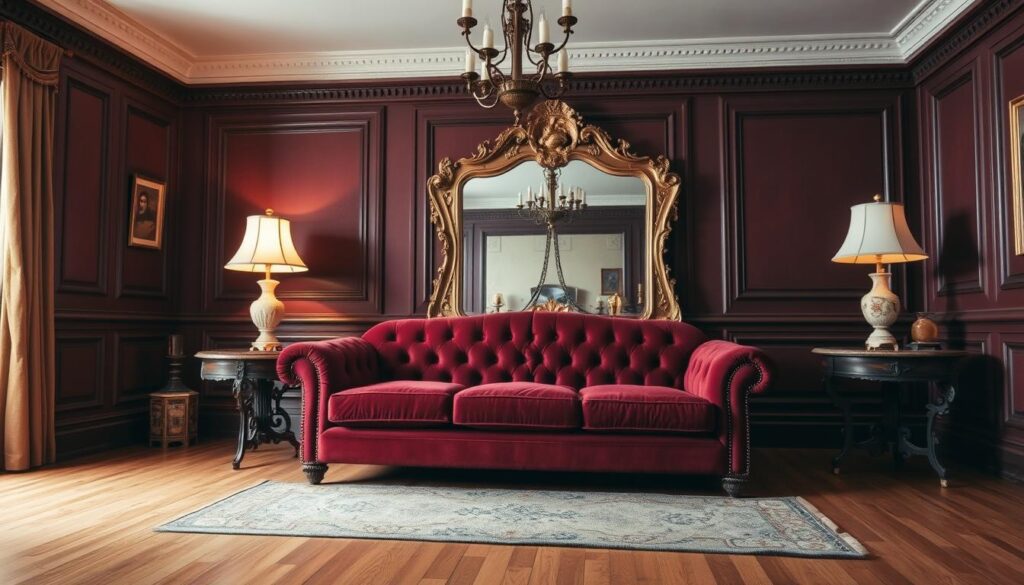
Key Vintage Design Eras Worth Exploring
The world of vintage design is rich with diverse eras, each offering unique elements to enhance your home. From the elegant curves of a Victorian armchair to the sleek lines of a mid-century modern coffee table, vintage furniture tells a story and creates a unique atmosphere in your home.
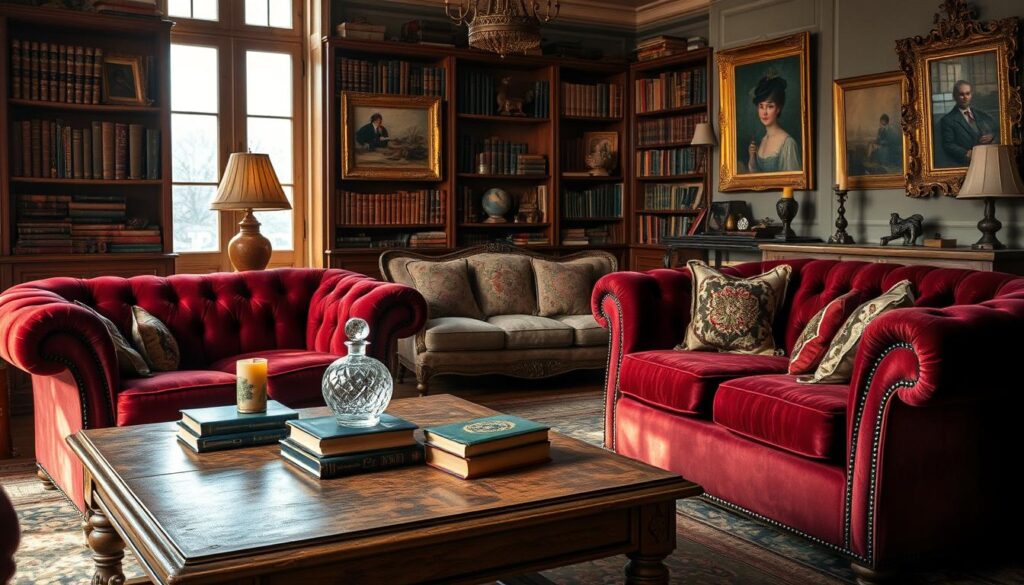
Mid-Century Modern (1940s-1960s)
Mid-Century Modern design is characterized by its emphasis on functionality, simplicity, and integration with nature. Iconic pieces include egg chairs and sleek wooden dressers. This era’s focus on clean lines and minimal ornamentation makes it easy to incorporate into modern decor.
Art Deco (1920s-1930s)
Art Deco is known for its glamorous and luxurious aesthetic, featuring geometric shapes, metallic materials, and bold colors. Statement pieces like vintage lighting fixtures or ornate mirrors can add a touch of sophistication to any room.
Victorian (1837-1901)
The Victorian era is marked by its opulence and intricacy, with ornate patterns, rich fabrics, and complex furniture designs. Incorporating a few carefully chosen Victorian pieces, such as a intricately carved wooden cabinet, can add depth and character to a modern space.
Industrial Revolution Era
The Industrial Revolution brought about a significant change in design, with the introduction of new materials and manufacturing techniques. Exposed brick, metal beams, and reclaimed wood are elements that can bring an industrial feel into your home.
Bohemian and Eclectic Styles
Bohemian and eclectic styles celebrate individuality and creativity, mixing different cultures, eras, and styles. A vintage rug paired with modern furniture and global textiles can create a unique and inviting atmosphere.
By exploring these vintage design eras, you can discover the perfect elements to blend with your modern style, creating a home that is both timeless and contemporary.
How to Incorporate Vintage Finds into Modern Decor
To create a unique and captivating interior, it’s essential to learn how to seamlessly integrate vintage pieces into your modern decor. Begin your design journey by selecting a statement vintage furniture piece, as this foundation will set the tone for the entire room.
The 60/40 Rule: Balancing Old and New
A good rule of thumb is to allocate 60% of your space to modern elements and 40% to vintage finds. This balance prevents the space from feeling overly cluttered or dominated by a single style.
Creating Focal Points with Statement Pieces
Vintage items can serve as excellent focal points. For instance, a vintage armchair can be the centerpiece of a reading nook, adding character and depth to the room.
Complementary Color Schemes That Bridge Eras
To unify different periods, consider color palettes that complement both vintage and modern elements. Neutral backgrounds can help vintage pieces stand out while maintaining a modern aesthetic.
Color Palettes That Unite Different Periods
| Era | Dominant Colors | Complementary Modern Colors |
|---|---|---|
| Mid-Century Modern | Earth tones, turquoise | White, gray, natural wood |
| Art Deco | Gold, silver, black | Bold colors, metallic accents |
Using Paint to Modernize Vintage Pieces
A fresh coat of paint can modernize vintage furniture, making it blend more seamlessly with modern decor. Choose colors that complement your existing palette.
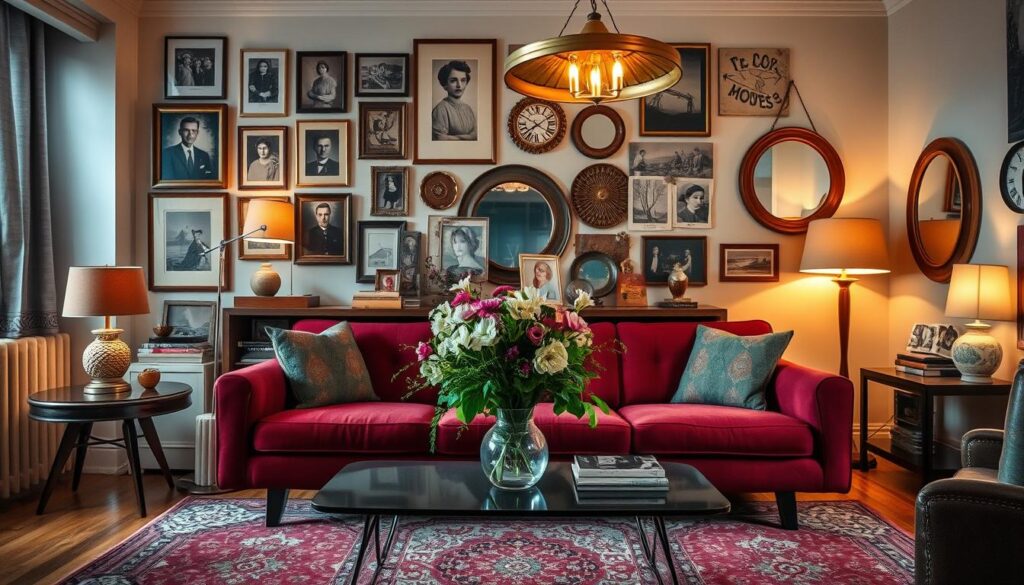
“The art of mixing vintage and modern elements is about creating a dialogue between different styles, resulting in a unique and captivating space.”
Vintage Furniture in Contemporary Spaces
Vintage pieces can bring a sense of history and authenticity to contemporary interiors. Incorporating vintage furniture into modern decor not only adds character but also tells a story, making a house truly feel like a home.
Selecting Pieces That Complement Modern Architecture
When choosing vintage furniture for a contemporary space, it’s essential to select pieces that complement the modern architecture. Look for vintage items with clean lines or unique details that can stand out against a minimalist backdrop.
Placement Strategies for Maximum Impact
Strategic placement of vintage furniture can significantly enhance the overall aesthetic of a room. Consider using vintage pieces as statement items or focal points within a space.
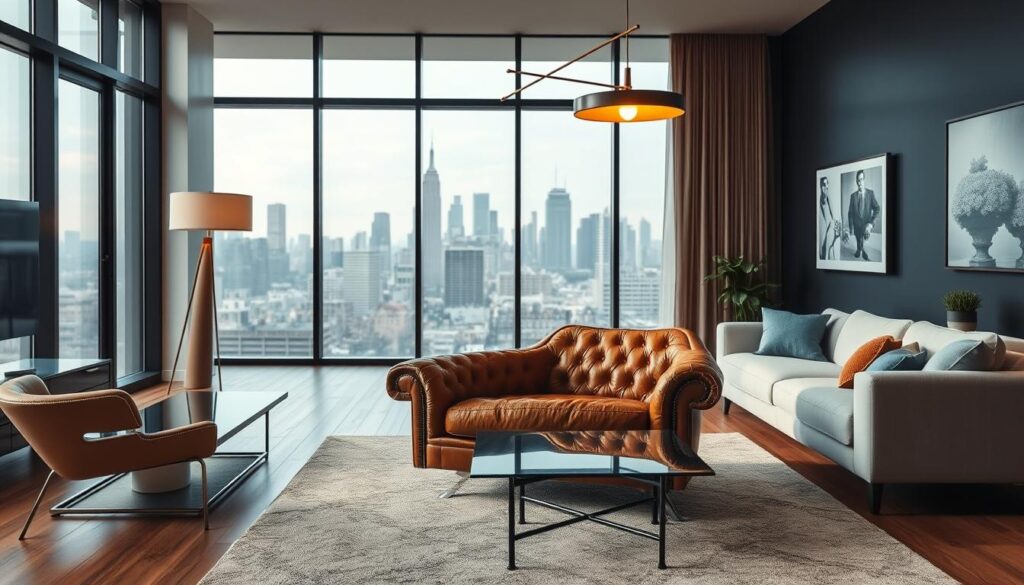
When to Reupholster vs. Preserve Original Fabrics
Deciding whether to reupholster or preserve the original fabrics of vintage furniture depends on the piece’s condition and your personal preference. Here are some considerations:
- If the fabric is in good condition but outdated, reupholstering might be the best option.
- If the original fabric is historically significant or holds sentimental value, preservation is likely the better choice.
Fabric Selection for Reupholstery Projects
When reupholstering, choose fabrics that complement the vintage piece’s original style while ensuring durability. Consider factors like texture, pattern, and color to achieve a harmonious blend.
Professional vs. DIY Upholstery Considerations
Whether to hire a professional or undertake a DIY upholstery project depends on the complexity of the task and your skill level. Professionals can handle intricate designs and ensure high-quality results.
| Consideration | Professional Upholstery | DIY Upholstery |
|---|---|---|
| Cost | Higher upfront cost | Potential for cost savings |
| Quality | High-quality finish | Variable quality depending on skill |
| Time | Faster completion | Time-consuming |
Mixing Textures and Materials Across Eras
The art of mixing textures and materials from different eras can elevate your interior design, creating a space that is both visually appealing and rich in character. By combining vintage and modern elements, you can achieve a unique aesthetic that reflects your personal style.
Pairing Wood Varieties from Different Periods
Pairing wood varieties from different periods can add warmth and depth to your space. For instance, combining a vintage oak table with modern walnut chairs creates an interesting contrast. This blend of old and new wood tones can make your dining area more inviting.
Incorporating Metals: Brass, Chrome, and Iron
Metals like brass, chrome, and iron can be incorporated in various ways to enhance your decor. A vintage brass lamp paired with a modern chrome side table can create a striking visual effect. Mixing metals from different eras can add a layer of sophistication to your space.
Textile Combinations That Tell a Story
Textiles play a crucial role in mixing vintage and modern elements. Layering vintage textiles with modern fabrics can create a rich tapestry that tells a story. For example, pairing a vintage Persian rug with modern linen upholstery can add depth and character to your living room.
Layering Vintage Textiles with Modern Fabrics
When layering vintage textiles with modern fabrics, it’s essential to balance patterns and textures. A good rule of thumb is to start with a dominant vintage piece and then complement it with modern elements. As one designer notes, “Combining these textures keeps your space from feeling one-dimensional.” This approach allows you to create a harmonious blend of old and new.
| Material | Vintage Example | Modern Example |
|---|---|---|
| Wood | Vintage oak table | Modern walnut chairs |
| Metal | Vintage brass lamp | Modern chrome side table |
| Textile | Vintage Persian rug | Modern linen upholstery |
“Combining different textures and materials is key to creating a space that feels layered and interesting.”
Room-by-Room Guide to Vintage-Modern Fusion
The blend of vintage and modern elements in home decor is a growing trend that offers endless possibilities for creativity and personal expression. This fusion can transform your living space into a unique and captivating environment.
Living Room: Creating Conversation Areas
Incorporating vintage pieces into your living room can create inviting conversation areas. Consider using vintage sofas or armchairs alongside modern coffee tables.
Vintage Lighting in Modern Settings
Vintage lighting fixtures can add a touch of elegance to modern settings. Look for antique chandeliers or sconces to create a striking focal point.
Coffee Tables and Side Tables That Bridge Styles
Mixing vintage and modern furniture can be achieved by pairing a vintage coffee table with modern side tables, creating a harmonious blend of styles.
Kitchen: Functional Vintage Elements
Vintage kitchenware and appliances can bring a nostalgic feel to your modern kitchen. Incorporate vintage elements to add character.
Incorporating Vintage Kitchenware and Appliances
Use vintage kitchenware as decorative pieces or functional items. Vintage appliances, when restored, can be both practical and stylish.
Bedroom: Nostalgic Comfort Meets Modern Simplicity
The bedroom is a perfect space to blend vintage comfort with modern simplicity. Vintage beds and dressers can be paired with modern bedding and lighting.
Bathroom: Small Vintage Touches in Modern Spaces
Even small vintage touches can make a big impact in modern bathrooms. Consider vintage mirrors, faucets, or decorative accessories.
Home Office: Vintage Desks and Modern Technology
A vintage desk can be the centerpiece of a home office, paired with modern technology and ergonomic furniture for a functional workspace.
A single standout piece can truly transform a space, as noted by interior design experts. By thoughtfully incorporating vintage elements into your modern decor, you can create a unique and personalized home.
| Room | Vintage Elements | Modern Elements |
|---|---|---|
| Living Room | Vintage Sofas, Lighting | Modern Coffee Tables, Decor |
| Kitchen | Vintage Kitchenware, Appliances | Modern Countertops, Fixtures |
| Bedroom | Vintage Beds, Dressers | Modern Bedding, Lighting |
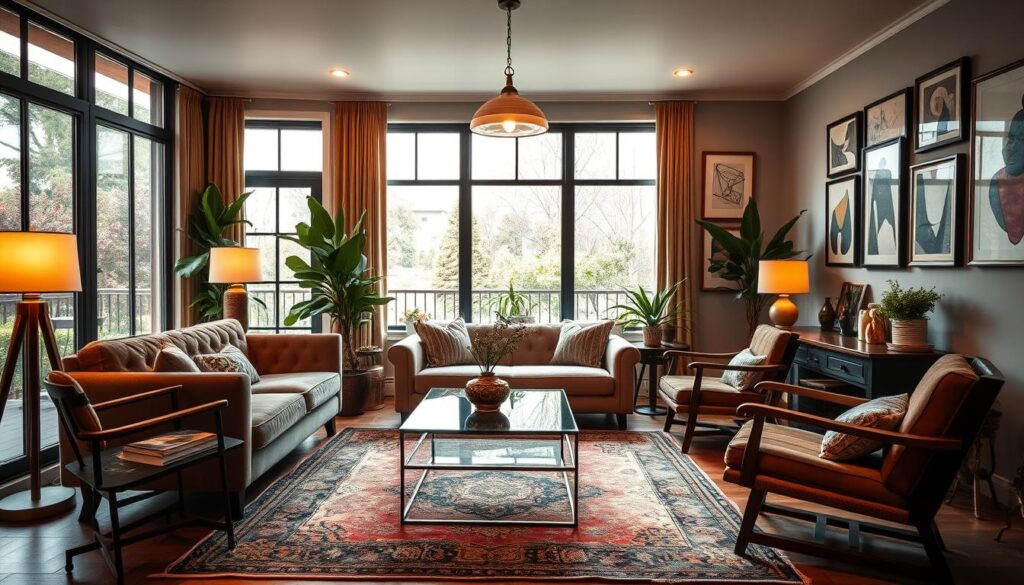
Sourcing Quality Vintage Pieces
Incorporating vintage elements into your home decor starts with sourcing the right pieces, a task that can be both exciting and challenging. Whether you’re a seasoned collector or just starting out, there are numerous avenues to explore in your quest for unique vintage finds.
Estate Sales and Auctions
Estate sales and auctions are treasure troves for vintage enthusiasts. These events offer a wide range of items, from antique furniture to vintage decorative pieces. To succeed, arrive early and be prepared to negotiate. Keep an eye out for high-quality, well-preserved items that fit your decor vision.
Thrift Stores and Flea Markets
Thrift stores and flea markets are excellent places to find hidden gems. While the inventory can be unpredictable, patience and a keen eye can lead to remarkable discoveries. Don’t be afraid to dig through the shelves and racks to uncover unique vintage pieces.
Online Marketplaces for Vintage Treasures
There are numerous sites that you can explore for vintage wall décor items online. Online marketplaces have made it easier than ever to find vintage items from the comfort of your home. Use specific keywords like “vintage home decor” or “antique furniture in contemporary space” to narrow down your search.
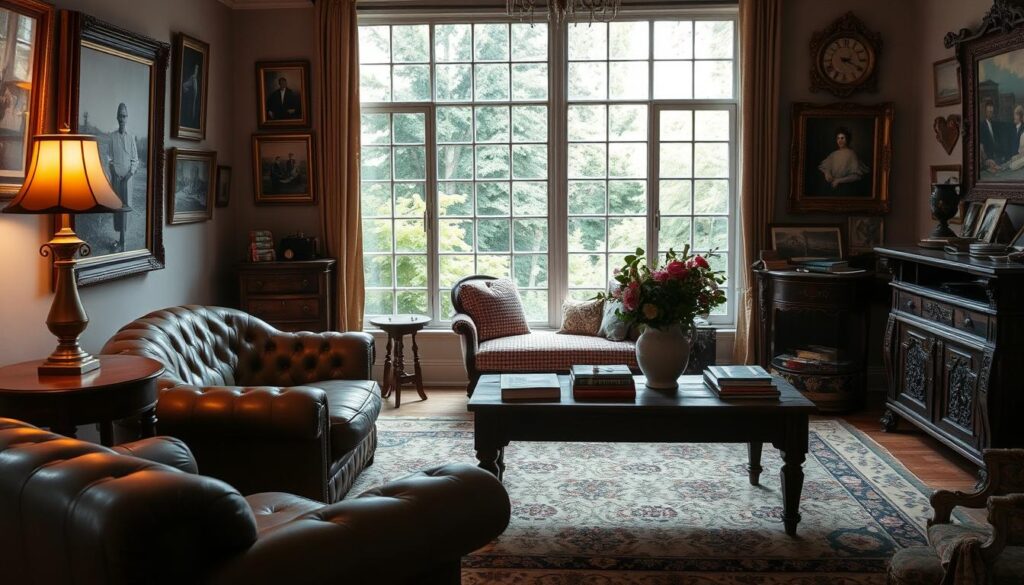
Family Heirlooms: Repurposing with Respect
Family heirlooms can add a personal touch to your vintage decor. When repurposing these items, it’s essential to honor their heritage while updating their function. Consider restoring or reusing them in a way that respects their original significance.
Honoring Heritage While Updating Function
When updating family heirlooms, think about how you can preserve their original character while making them functional in your modern space. This might involve refinishing, reupholstering, or repurposing the item in a creative way that still honors its history.
- Research the item’s history to understand its significance.
- Choose restoration methods that preserve the original material and craftsmanship.
- Consider how the item can be used in your home while maintaining its nostalgic value.
DIY Restoration and Upcycling Techniques
With the right tools and a bit of know-how, you can transform vintage finds into stunning pieces that add character to any room. Updating your home with vintage pieces not only adds a touch of history but also contributes to a more sustainable lifestyle by reusing and repurposing existing items.
Basic Restoration Skills Every Vintage Lover Should Know
Restoring vintage furniture begins with understanding the basics. This includes knowing how to assess the condition of a piece, identifying the materials used, and determining the best restoration approach.
Essential Tools for Furniture Restoration
- Screwdrivers and pliers for disassembly
- Sanding tools for smoothing surfaces
- Paintbrushes for applying finishes
- Clamps for holding pieces together during repair
Cleaning Methods for Different Materials
Different materials require different cleaning approaches. For instance, wood can be cleaned with a mild soap solution, while metal may require a specific cleaner to avoid corrosion.
| Material | Cleaning Method |
|---|---|
| Wood | Mild soap and water |
| Metal | Specific metal cleaner |
| Fabric | Gentle vacuuming or dry cleaning |
Refinishing Wood Without Losing Character
You can refinish wood on your own if you don’t like the patina. The process involves stripping the old finish, sanding the surface, and applying a new stain or finish. This not only revives the piece but also allows you to personalize it to your taste.
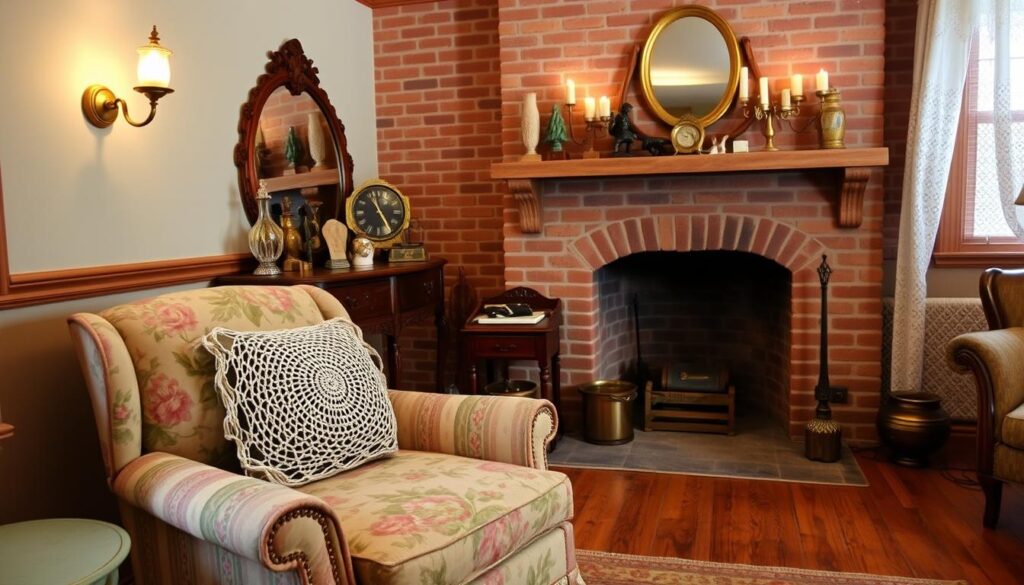
Modernizing Vintage Pieces While Preserving Their Soul
Mixing vintage and modern elements can create a unique aesthetic. When modernizing vintage pieces, consider updating the hardware or reupholstering with modern fabrics to give them a fresh look.
Hardware Updates That Respect Original Design
Updating hardware can significantly modernize a vintage piece. Choose new hardware that complements the original design to maintain its integrity.
By applying these DIY restoration and upcycling techniques, you can seamlessly integrate vintage pieces into your modern home decor, creating a space that is both stylish and rich in character.
Styling and Accessorizing with Vintage Finds
When done correctly, mixing vintage and modern elements can create a truly unique aesthetic. The art of styling with vintage finds lies in striking a balance between old and new, ensuring that each piece complements the other.
Vintage Art and Photography in Modern Frames
One way to blend vintage with modern is by incorporating vintage art or photography into contemporary frames. This not only preserves the vintage essence but also gives it a fresh look. For instance, a vintage black and white photograph in a sleek, modern frame can add a touch of sophistication to any room.
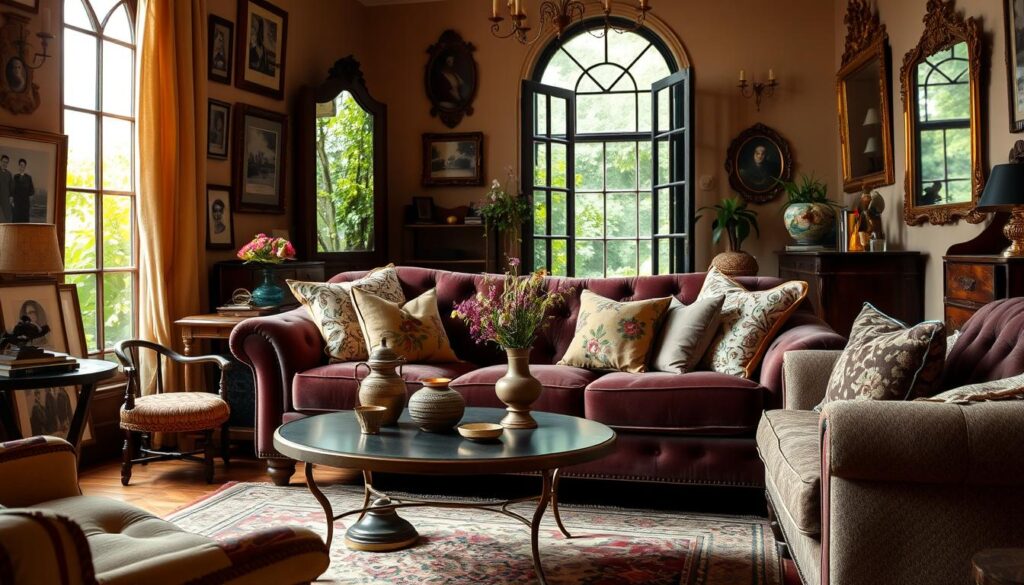
Displaying Collections Without Overwhelming Spaces
Displaying vintage collections can be a challenge. The key is to curate your collection in a way that it becomes a focal point without overwhelming the space. Creating vignettes or grouping similar items together can help achieve this balance.
Seasonal Rotation of Vintage Decor Elements
Rotating your vintage decor elements seasonally can keep your space feeling fresh and dynamic. For example, switching out vintage summer-themed decor for winter pieces can create a timely and inviting atmosphere. Creating small vintage vignettes can be a great way to showcase your favourite pieces, as noted by interior design experts.
Creating Vignettes That Tell Stories
Vignettes are an effective way to tell a story through your decor. By grouping vintage items that share a common theme or era, you can create a narrative that adds depth to your space. For instance, a collection of vintage cameras on a shelf can evoke memories of photography’s past.
| Vintage Element | Modern Twist | Result |
|---|---|---|
| Vintage Photograph | Modern Frame | Sophisticated Decor |
| Vintage Camera Collection | Minimalist Shelf | Nostalgic Focal Point |
| Vintage Summer Decor | Seasonal Rotation | Fresh Seasonal Look |
By thoughtfully incorporating vintage finds into your decor, you can achieve a unique blend of nostalgia and modernity. Whether through art, collections, or seasonal decor, the possibilities are endless.
Common Mistakes When Mixing Vintage and Modern
Mixing vintage and modern styles requires a thoughtful approach to avoid common pitfalls. One of the most significant challenges is striking the right balance between old and new elements.
Avoiding the “Museum Effect”
Too much vintage can make a space feel like a museum. To avoid this, it’s essential to integrate vintage pieces into your modern decor in a way that feels organic and lived-in. Balance is key.
Preventing Style Clashes
When combining different styles, there’s a risk of creating a space that feels disjointed. To prevent this, focus on finding common ground among your vintage and modern pieces, such as a unifying color scheme or texture.
Balancing Functionality with Aesthetics
While aesthetics are crucial, functionality should not be overlooked. Ensure that your vintage finds serve a purpose or contribute to the overall comfort of your space.
When to Pass on a Vintage Find
Sometimes, it’s necessary to know when to let go of a vintage piece. If it doesn’t fit with your overall aesthetic or serve a functional purpose, it might be best to pass on it.
| Common Mistake | Solution |
|---|---|
| Overusing vintage pieces | Balance vintage with modern elements |
| Ignoring functionality | Ensure vintage pieces serve a purpose |
| Failing to unify styles | Use a common color scheme or texture |
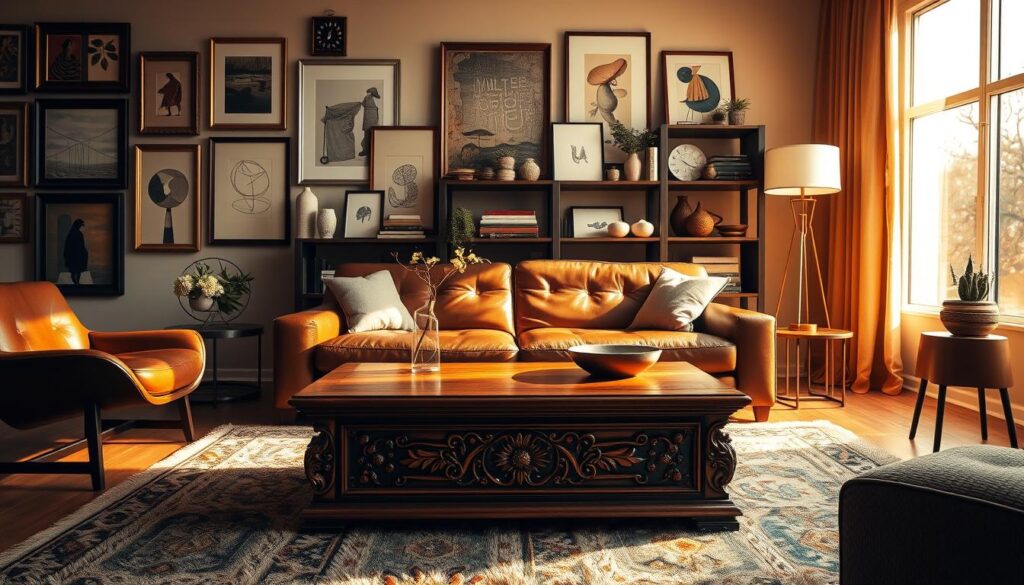
Conclusion: Creating Your Unique Vintage-Modern Home
Blending vintage and modern elements can transform your living space into a warm, stylish, and uniquely personal haven. By incorporating vintage finds into modern decor, you can add character and depth to your home. The key is to strike a balance between old and new, creating a harmonious fusion that reflects your personal style.
When mixing vintage and modern elements, consider the 60/40 rule, where 60% of the room is a dominant style, and 40% is the secondary style. This balance allows you to create a cohesive look while still showcasing your vintage treasures. Vintage home decor can include antique furniture, vintage accessories, or retro-inspired pieces that add a touch of nostalgia to your space.
By thoughtfully combining vintage and modern elements, you can create a space that feels truly yours. As you incorporate these elements, remember that your home should feel like you, and with a few carefully chosen vintage pieces, you can make it feel warm, stylish, and uniquely yours.



